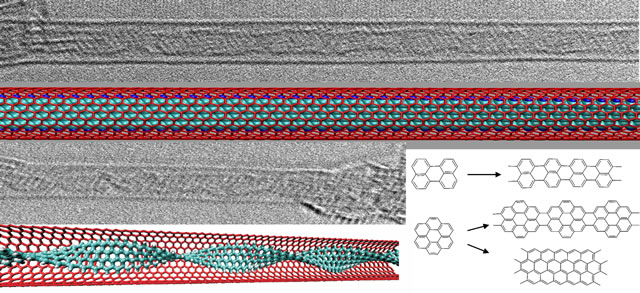Researchers at the Aalto University and the Umea University in Finland have developed a new hybrid carbon material by combining Single Wall Carbon Nanotubes (GNR@SWNT) and graphene nanoribbons.
 High resolution TEM images of graphene nanoribbons encapsulated in SWNTs, simulated structures of flat and helical nanoribbons inside of nanotubes and scheme of chemical reaction which results in formation of nanoribbons from coronene and perylene molecules.
High resolution TEM images of graphene nanoribbons encapsulated in SWNTs, simulated structures of flat and helical nanoribbons inside of nanotubes and scheme of chemical reaction which results in formation of nanoribbons from coronene and perylene molecules.
SWNTs have a hollow space, in which different types of chemical reactions occur. Due to this feature, the hollow space was used as a chemical reactor with a single dimension for the purpose of the study.
The SWNTs were then filled with narrow and long graphene nanoribbons. The graphene nanoribbons were made from perylene and coronene, which are polyaromatic hydrocarbon molecules and are large in size. The shape of the graphene nanoribbons could be altered by adding different kinds of polyaromatic hydrocarbon molecules. Both SWNTs and nanoribbons can be semiconducting or metallic. SWNTs can also be insulating.
Due to this feature, GNR@SWNT can be developed in various combinations. They can be synthesised in an easy manner, due to which the production scale can be increased. The nanotubes can also be fully filled with nanoribbons. The angle and width of the nanoribbons can also be controlled to assemble graphene-based materials. Examples of various combinations that can be achieved are metallic nanoribbons inside an insulated nanotube to create light. Semiconducting nanoribbons can be used for applications involving solar cells and transistors. A combination of metallic nanoribbons and metallic SWNTs can also be used as a new variety of coaxial nanocables. These nanocables are used to transmit radio signals.